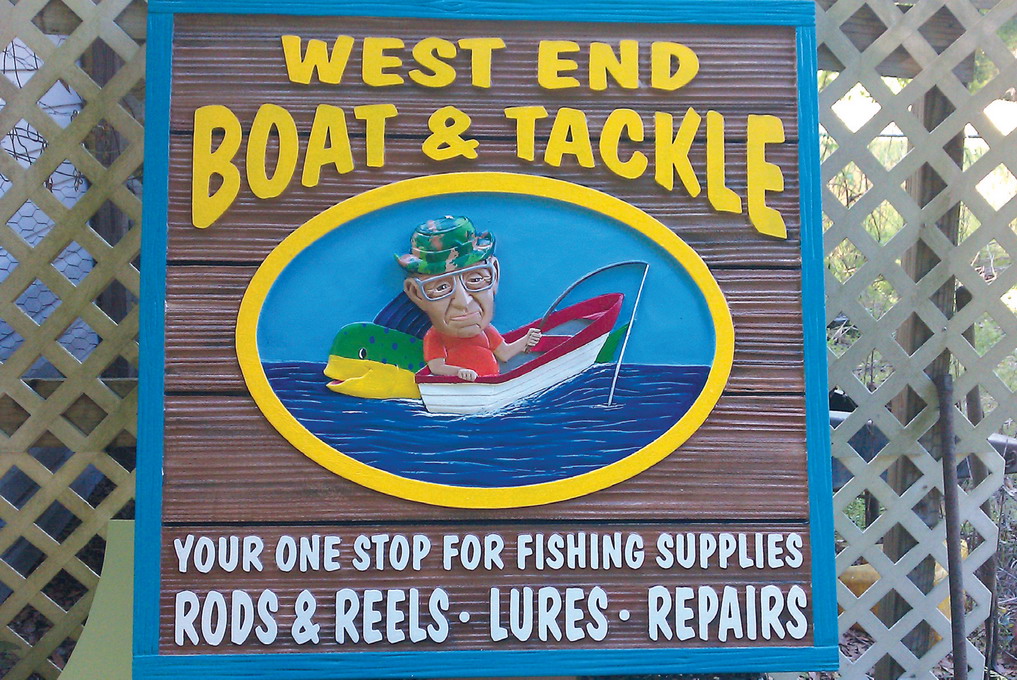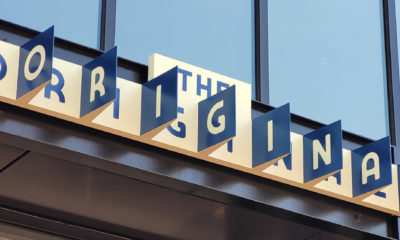I’ve been making signs for roughly 25 years. Over the years, I’ve produced signs for such diverse customers as military bases, residential developments and Tampa’s local zoo, among others. I recently enjoyed creating a sign that would help build my reputation overseas.
Sondra Hill came into my shop and wanted to purchase a 4 x 4-ft. sign for her father, who owns a bait-and-tackle shop in Honduras. She’d grown up in Honduras, married a Marine and moved to the U.S. Sondy found me through a web search, and wanted a distinctive, 3-D sign. The “information superhighway” has become a very effective sales tool.
Sondra wanted a panel that featured her father as a caricature. I asked for a picture of him and began recreating him with a hand sketch. I created the other elements using CorelDraw 11.
Her father is an avid fisherman, so that presented a natural theme. And, for a dose of good-natured humor, in the background I added a dolphin, which mocks the caricature because the fish aren’t biting.
I plotted the pattern, using a Master™ TC 3000 vinyl plotter on Anchor Continental 226 high-tack stencil film, and applied it to the substrate – 1.5-in.-thick, 15-lb. HDU. I use both Signs Art Products’ Sign*Foam 3 and Coastal Enterprises’ PrecisionBoard. They both work well (and both companies feature my work on their website galleries, so I’m impartial). They’re superior to wood because they won’t rot or split; they carve consistently and absorb paint better.
I sandblasted the panel using a Smith 100 large air compressor and a 300-lb. sandpot filled with Dupont’s Starblast™ staurolite-sand abrasive. It was created to fabricate steel components and remove rust from bridges, but I’ve found it blasts through HDU cleanly and effectively. I blasted at 80 psi for 45 minutes to achieve the desired depth.
Advertisement
To create fine details, I used a mixture of chisels, sanders, saws and a Dremel tool. To create the texture, I built my own grain frame. I think the commercially available versions create a surface texture that’s too uniform and doesn’t resemble real wood. An uneven pattern, with the occasional dimple or divot, looks more authentic.
To create the caricatured face, I carved an appliqué using HDU that’s bonded to the panel’s surface with Gorilla Glue. I decorated the signface with Color Wheel’s acrylic-latex paint, which I use for all my signs.
However, there’s one exception: when a job requires gold paint, I coat with a different vendor’s latex product. It’s better than what my competitors use, so I’m keeping it a secret. I only use vinyl on removable nameplates or if the customer requires it.
Normally, when I ship signs, I pack them in a plywood frame secured with 2 x 4s and sheathed in bubble wrap. But, Sondy will ship her father the sign, so I was spared creating a heavy-duty crate that would travel several thousand miles.
I love that every day brings unique opportunities. I’m proud of the small part I’ve played in helping make Tampa a more beautiful place. And, it’s gratifying to know that, thousands of miles away, my sign might give someone, looking for lures to fish with along the Honduran coastline, a smile.
Equipment and Materials
Appliqué: Three-dimensional appliqué made with Abracadabra Smooth & Sculpt two-part epoxy, from Abracadabra Signs (Ayr, ON, Canada), (877) 342-0847 or www.abracadabrasigns.com
Advertisement
Paint: Color Wheel acrylic-latex paint, from The Comex Group (Greenwood Village, CO), (720) 873-3060 or www.colorwheel.com
Plotter: Master TC3000 vinyl plotter, from Master Warehouse (Orlando), (877) 893-3729 or www.masterwarehouse.com
Sandblasting: Smith 100 large air compressor, from Air-Equip Direct (South Bend, IN), (219) 324-0481 or www.smithcompressors.com
Software: Photoshop®, from Adobe (San Jose, CA), (408) 536-6000 or www.adobe.com; CorelDraw X4 software, from Corel Corp. (Ottawa, ON, Canada), www.corel.com
Stencil: Anchor 226 sandblasting stencil, from such suppliers as Midwest Sign & Screen Supply Co. (St. Paul, MN), (800) 328-6592 or www.midwestsign.com
Substrate: Fifteen-lb. HDU, from Sign Arts Products (Laguna Hills, CA), (800) 338-4030 or www.signfoam.com, or Coastal Enterprises (Orange, CA), (800) 845-0745 or www.precisionboard.com
Advertisement
Tools: Dremel tool, saws, chisels and sanders, available at home-improvement or building-supply stores
More About Mike
A 25-year veteran of handcarved- and sandblasted-sign fabrication, Mike Bethune founded Bethune Signs Inc. in the Tampa area in 1990. He learned sandblasting and engraving at the tombstone and monument foundry where his father worked, but, after having worked at a different monument fabricator, he opted to become a signmaker.
His portfolio includes signs for numerous doctors and attorneys, state and county parks, the Florida Aquarium, MacDill AFB, the Tampa Zoo and numerous residential developments. He also served as a judge for this year’s International Sign Contest (see ST, April 2010, page 63). He moved to his current shop in Thonotosassa, a Tampa suburb, in 2001.
His “calling card” is his shop vehicle, a Chevrolet HHR that’s outfitted with a 3-D sculpture of a sleeping man that’s secured to both rear side panels. A larger version was attached to his former mode of transportation, a 1954 panel truck.
“People would freeze on the sidewalk, wondering if that was a real guy dozing on the side of the truck,” he said.
For more information about Mike and his shop, see his Shop Next Door profile (see ST, March 2009, page 60) or visit www.bethunesigns.com



 Tip Sheet1 week ago
Tip Sheet1 week ago
 Photo Gallery2 days ago
Photo Gallery2 days ago
 Ask Signs of the Times3 days ago
Ask Signs of the Times3 days ago
 Real Deal1 week ago
Real Deal1 week ago
 Benchmarks6 days ago
Benchmarks6 days ago
 Editor's Note2 weeks ago
Editor's Note2 weeks ago
 Women in Signs1 week ago
Women in Signs1 week ago
 Photo Gallery1 week ago
Photo Gallery1 week ago







